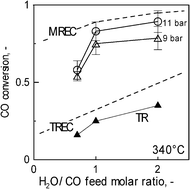Medium/high temperature water gas shift reaction in a Pd–Ag membrane reactor: an experimental investigation
Abstract
In the

* Corresponding authors
a
National Research Council–Institute on Membrane Technology (ITM–CNR) Via Pietro BUCCI, c/o The University of Calabria, cubo 17C, Rende CS, Italy
E-mail:
g.barbieri@itm.cnr.it
Fax: +39 0984 402103
Tel: +39 0984 492029
b The University of Calabria - Department of Chemical Engineering and Materials, cubo 44A Via Pietro BUCCI, Rende CS, Italy
In the

 Please wait while we load your content...
Something went wrong. Try again?
Please wait while we load your content...
Something went wrong. Try again?
A. Brunetti, E. Drioli and G. Barbieri, RSC Adv., 2012, 2, 226 DOI: 10.1039/C1RA00569C
To request permission to reproduce material from this article, please go to the Copyright Clearance Center request page.
If you are an author contributing to an RSC publication, you do not need to request permission provided correct acknowledgement is given.
If you are the author of this article, you do not need to request permission to reproduce figures and diagrams provided correct acknowledgement is given. If you want to reproduce the whole article in a third-party publication (excluding your thesis/dissertation for which permission is not required) please go to the Copyright Clearance Center request page.
Read more about how to correctly acknowledge RSC content.
 Fetching data from CrossRef.
Fetching data from CrossRef.
This may take some time to load.
Loading related content
